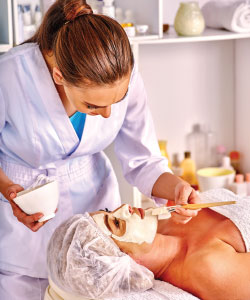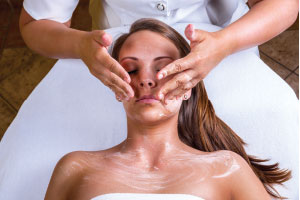With pigmentation issues being one of the most frequently addressed concerns in professional skin care, it is important to understand that there is no longer a sole culprit of dark spots. Skin care professionals used to think that the most stubborn forms of hyperpigmentation were either sun damage related or hormonally induced, but new research suggests that there are numerous other sources and factors that play a role in skin discoloration. This information causes professionals to rethink how they treat every client because different ingredient technologies can help address their clients' specific concerns.
 Today, professionals see a myriad of pigmented spots, all of which stem from different sources: ultraviolet-induced pigmentation, which can cause color variations from light-to-dark brown; glycation-induced pigmentation, which mainly causes yellowing of the skin on the cheeks and forehead; lipofuscin-induced pigmentation, which causes deep, dark yellow-to-brown spots produced by insufficient cellular detoxification; and, most recently, professionals are finally starting to understand how pollution and modern technology also contribute to various melanocyte disorders and damage ranging from hyper- to hypopigmentation. Each one of these disorders requires a specialized and targeted approach.
Today, professionals see a myriad of pigmented spots, all of which stem from different sources: ultraviolet-induced pigmentation, which can cause color variations from light-to-dark brown; glycation-induced pigmentation, which mainly causes yellowing of the skin on the cheeks and forehead; lipofuscin-induced pigmentation, which causes deep, dark yellow-to-brown spots produced by insufficient cellular detoxification; and, most recently, professionals are finally starting to understand how pollution and modern technology also contribute to various melanocyte disorders and damage ranging from hyper- to hypopigmentation. Each one of these disorders requires a specialized and targeted approach.
One size does not fit all and one specific ingredient or treatment is no longer sufficient to successfully treat pigmentation. Modern problems need modern solutions.
This powerful oxygenating and illuminating facial treatment will help fight the three biggest aging factors: smoking, environmental damage, and sun damage. All three factors contribute to a more pronounced pigmentation, as well as loss of firmness and other aging manifestations. The results from this treatment will not only help fade multiple signs of discoloration, but also firm, tighten, and revitalize dull, pigmented complexions. Ideally, a series of at least four treatments is recommended to treat stubborn pigmented spots, but even one treatment will visibly reboot the skin's oxygen supply, fade surface discoloration and dark spots, and boost firmness and elasticity, resulting in a smoother, visibly brighter and illuminated appearance. The cost of the treatment should range from $150 to $175 for 60 to 90 minutes, depending on the exfoliation techniques chosen and modalities used.
STEP-BY-STEP PROTOCOL
1. Begin by applying a mild exfoliating cleansing gel containing natural fruit acids to gently remove surface impurities and dull, pigmented cells, and cotton stem cells, to minimize the impact of environmental pollutants embedded in
the pores.
2. After massaging the cleanser into the skin, focusing on areas of congestion for two minutes, remove it with sponges and
warm water.
3. Tone and degrease the skin with a pH preparation solution prior to any resurfacing treatment. To do so, saturate a cotton pad and wipe the client's entire face to remove excess oils. Prepare their skin with a mild acid solution blend of glycolic, lactic, and salicylic acids. It is best that no oil-soluble residue of any kind is left on the skin prior to the acid peel application.
4. If an enzyme mask is preferred, blend equal parts of an enzyme powder containing skin-friendly papaya, pineapple, cranberry, or pumpkin enzymes with an activating solution that contains vitamin B3/niacinamide to further boost cellular energy and brighten the skin; blend the mixture until it is smooth. Apply the mixture with a soft fan brush to the client's moist face, neck, and décolletage using smooth, even strokes. Avoid the corners of their eyes and mouth.
5. Steam their face, neck, and décolletage for five to 10 minutes to increase enzyme exfoliation activity, then thoroughly remove the solution with cool or warm water.
6. If a multi-acid peel is preferred, the professional should use a cotton swab and quickly apply a thin layer of a brightening and clarifying peel solution, combining the powerful action of glycolic, mandelic, azelaic, and salicylic acids, which radically lifts dark spots and pigment while purifying congested pores and softening old scars and rough, uneven texture. Avoid eye area during application.
7. After two to five minutes, remove the peel with cool water, rinsing over the treated area several times to ensure the solution has been thoroughly removed.
8. Perform extractions on the client, if needed.
9. Next, use a hydrating and reparative recovery complex that is rich in hyaluronic acid, yeast extracts, and skin-calming saccharides to  provide a swift cooling sensation, reduction of redness, and instantly calm and hydrate the client's skin. This step is very important because it is not only geared towards ensuring that any hydration lost during exfoliating is replenished, but also that the skin is soothed and potential inflammatory reactions that can lead to a new offset of pigmentation is under control.
provide a swift cooling sensation, reduction of redness, and instantly calm and hydrate the client's skin. This step is very important because it is not only geared towards ensuring that any hydration lost during exfoliating is replenished, but also that the skin is soothed and potential inflammatory reactions that can lead to a new offset of pigmentation is under control.
10. To replenish lost barrier nutrients and lipids, apply a nourishing cream with omega fatty acids and gently massage it into the skin until it is absorbed.
11.Apply an oxygenating and antioxidant mask that restores an even-toned, calm, and glowing complexion.
12. Work in a blend of a cell-energizing antioxidant serum concentrate that contains powerful detoxifying and anti-pollution actives that invade the pores and cause a cascade of damage that intensifies dark spots on the skin, and a vitamin C serum, that further discourages pigment formation and increases the skin's firmness. Apply this serum to the client's entire face, neck, and décolletage.
 13. Apply a combination of a brightening niacinamide and a rejuvenating peptide treatment moisturizer to the client's skin. Now is a great time to educate the client about the importance of consistently using homecare products in the successful treatment of hyperpigmentation. Having a compliant client that regularly uses quality homecare products exponentially increases the success rate of professional treatments.
13. Apply a combination of a brightening niacinamide and a rejuvenating peptide treatment moisturizer to the client's skin. Now is a great time to educate the client about the importance of consistently using homecare products in the successful treatment of hyperpigmentation. Having a compliant client that regularly uses quality homecare products exponentially increases the success rate of professional treatments.
14. Gently apply an eye cream that addresses multiple changes experienced by aging eyes and targets smartphone-squint due to sources of high-energy visible (HEV) light. Phyto-melanin is one of the rare action ingredients that helps shield the eye area from exposure to sources of HEV light, while also reducing pigment fluctuations and protecting against sun-induced damage.
15.Conclude the treatment by applying an SPF of 15 or higher to the client's entire face, neck, and décolletage, followed by a light layer of a skin-protecting emulsion that blocks the adhesion of airborne car-exhaust and smoke-generated pollutants. Lastly, educate the
client about the importance of daily sun-care application and environmental protection.
 Ashley Stowers is a national educator and account executive for YG Laboratories and CelleClé Skincare. In addition to her role in sales, Stowers provides hands-on support in all aspects of education and product knowledge training, protocol development, and effective business merchandising. With over 15 years of experience in sales and education, holding positions as an aesthetics instructor and skin care therapist, Stowers possesses a very broad and unique understanding of the professional world and skin care industry.
Ashley Stowers is a national educator and account executive for YG Laboratories and CelleClé Skincare. In addition to her role in sales, Stowers provides hands-on support in all aspects of education and product knowledge training, protocol development, and effective business merchandising. With over 15 years of experience in sales and education, holding positions as an aesthetics instructor and skin care therapist, Stowers possesses a very broad and unique understanding of the professional world and skin care industry.
Want to read more?
Subscribe to one of our monthly plans to continue reading this article.